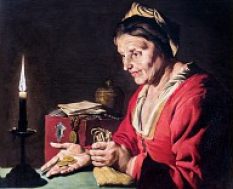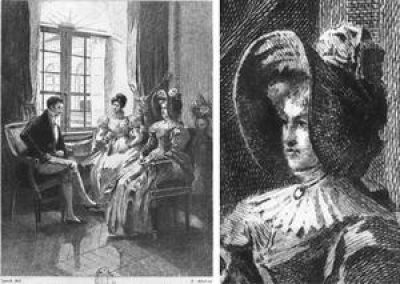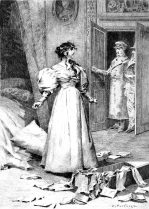
Gobseck
THE HUMAN COMEDY – Honoré de Balzac Second volume of works of Honoré de Balzac edited by widow André Houssiaux, publisher, Hebert and Co, successors, 7 rue Perronet – Paris (1877) Scenes from private life

Greed
GOBSECK Analysis of the work Gobseck appeared in 1830 in the first series of Scènes de la vie privée, designed to show young girls and women the pitfalls and dangers of using pawnbrokers: when women become their customers, it’s because some misfortune forces them to do so. This portrait of Gobseck, a loan shark, serves above all to show a secret drama of private life. The young woman who comes to borrow against her jewels does so to save her lover. But almost immediately the husband (Count de Restaud) arrives, who knows everything. He buys back the diamonds and explains to Gobseck that he wants to disinherit his younger sons, who are not his, in order to reserve his fortune for the eldest. Gobseck advises him to pretend to squander his fortune and offers to keep it for the eldest child. It is the solicitor who tells this story to the Grandlieu family, the same as Beatrix’s, to explain the origin of the fortune of the young Count Ernest de Restaud, whom he proposes to for Camille, sister of Sabine de Grandlieu.

Jean-Esther van Gobseck
Paris, January 1830
History The scene opens in Madame de Grandlieu’s salon, in conversation with her daughter Camille and a family friend, the solicitor Maître Derville. The latter learns that Camille is in love with young Ernest de Restaud, son of Anastasie de Restaud, née Goriot. Madame de Grandlieu disapproves of this love: Ernest’s mother is a spendthrift, bogged down in an illegitimate relationship with Maxime de Trailles, for whom she squanders her fortune. Derville intervenes on Camille’s behalf, demonstrating that Ernest has recently been awarded the entire family inheritance. This story, a mise en abîme of a human type from the Balzacian world, highlights the characters of Jean-Esther van Gobseck, a loan shark, and Maître Derville, a lawyer at the start of his career. These two characters, who play an essential role in this novel, reappear throughout the entire Human comedyeither in the form of an evocation: Gobseck, or in person: Maître Derville, featured in Le Colonel Chabert, Splendours and miseries of courtesans and in many other volumes of the Comédie humaine. Gens de robe honest.

Madame de Restaud
The organization of this work is deceptive: while the story is indeed about Camille’s marriage, Balzac’s main concern is to depict, as a true “passionate visionary” (Beaudelaire , L’Art poétique), the life of a little-known type: that of the usurer – for of course, in painting such a character, Balzac is being critical of avarice, as we see at the end of the novel, with myriads of commodities piled up here and there. But it’s not  Balzac’s criticism of avarice is aimed at society as a whole. It’s the French Restoration (at the time of the story, circa 1829), and the nobles are back in their place, the envy of all. Unfortunately, nobility is not so easily acquired. At least, you’d think so, because above all money reigns, and with it the marriage of convenience between fallen nobility and the rich bourgeoisie; everything can be bought in this world. It is this submission to money that Balzac emphasizes, by staging (we are in the Human comedy) the viscountess de Grandlieu, who invokes the pretext of noble prejudice (Ernest is the son of an unworthy commoner who is ruining her family) to refuse her daughter’s marriage to Ernest de Restaud, when the most important thing is obviously that her family is penniless!
Balzac’s criticism of avarice is aimed at society as a whole. It’s the French Restoration (at the time of the story, circa 1829), and the nobles are back in their place, the envy of all. Unfortunately, nobility is not so easily acquired. At least, you’d think so, because above all money reigns, and with it the marriage of convenience between fallen nobility and the rich bourgeoisie; everything can be bought in this world. It is this submission to money that Balzac emphasizes, by staging (we are in the Human comedy) the viscountess de Grandlieu, who invokes the pretext of noble prejudice (Ernest is the son of an unworthy commoner who is ruining her family) to refuse her daughter’s marriage to Ernest de Restaud, when the most important thing is obviously that her family is penniless!
Gobseck’s portrait “This singular man had never wanted to see a single person of the four female generations in which his parents lived. He abhorred his heirs and could not conceive of his fortune ever being owned by anyone other than himself, even after his death. At the age of ten, his mother embarked him as a ship’s boy for the Dutch possessions in the Indies, where he spent twenty years. And the wrinkles on his yellowish forehead held the secrets of horrific events, sudden terrors, unhoped-for chances, romantic crossings, infinite joys: hunger endured, love trampled underfoot, fortune compromised, lost, regained, life repeatedly in danger, and saved perhaps by those determinations whose swift urgency excuses their cruelty. He had known M. de Lally , M. de Kergarouêt, M. D’estaing, the Bailli de Suffren, M. de Portenduère, Lord Cornwallis, Lord Hastings, Tippo-Saeb’s father and Tippo-Saeb himself. This Savoyard, who served Madhadji-Sindiah, the king of Delhy, and contributed so much to founding the power of the Marhattes, had done business with him. He had been in contact with Victor Hughes and several famous privateers, as he had spent a long time on St. Thomas. He had tried so hard to make his fortune that he had tried to discover the gold of this tribe of savages so famous in the vicinity of Buenos-Ayres. Finally, he was no stranger to any of the events of the American War of Independence. But when he talked about the Indies or America, which he never did with anyone, and very rarely with me, it seemed like an indiscretion, and he seemed to repent it. If humanity, if sociability, were a religion, he could be considered an atheist.“
Genealogy of characters Gobseck: Jean-Esther van Gobseck, an Antwerp Jew and loan shark (1740-1830) had a great-niece, Sarah, known as La Belle Hollandaise, who was murdered in 1818. This Sarah had a daughter, Esther, born in 1805, whose nickname was La Torpille, a prostitute who eventually committed suicide out of love for Lucien de Rubempré. Restaud (de) : Noble family (a Restaud is cited as commanding the Warwick before 1789) represented by the Count of Restaud (1774-1824). Married Anasthasie Goriot (born around 1792), from whom : Ernest, born 1818. Marries Camille de Grandlieu ; Georges, probable son of Maxime de Trailles; Pauline, probable daughter of Maxime de Trailles; Grandlieu (de): Noble family represented by : Duke Ferdinand, who married an Ajuda (Portuguese), resulting in a religious daughter, Clotilde-Frédérique born 1802, Joséphine marries Ajuda, Sabine married Calyste Du Guénic, Marie-Athénaïs who married her cousin Juste : The youngest branch of this family is represented by a viscount of Grandlieu who died in 1823; He married a Born who gave birth to : Juste married his cousin Marie-Athénaïs and took over the ducal title. Camille, promised to Ernest de Restaud. We should also mention : a 17th-century Countess de Grandlieu, whose daughter married the Duc d’Hérouville. a Grandlieu who married the Marquis d’Espard, father of Marquis Andoche, a Grandlieu who married a Listomère, a Grandlieu who married the Prefect of Orne Derville: Lawyer, born in 1794. Marries Fanny Malvaut, father of daughter Mathilde, who marries Augustin Bongrand. Trailles (de): Born circa 1792 – married a woman we have every reason to believe was Cécile Beauvisage, born in 1820.
1) Source analysis: Preface compiled from the complete works of the Comédie Humaine (Volume V) published by France Loisirs 1985 under the auspices of the Société des Amis d’Honoré de Balzac.
2) Source story: Wikipedia, the universal encyclopedia.
3) Gobseck portrait source: Wikipedia Universal Encyclopedia. 4) Character genealogy source: Félicien Marceau “Balzac et son monde – Gallimard” (Balzac and his world – Gallimard)
No Comments